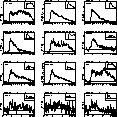The basic criterion for the classification of optical counterpart candidates
is the appearance of the high-resolution density spectra.
A small collection of typical spectra are shown in Fig. 2 (click here).
In some of the brighter density spectra
emission lines (cf. classification CV, QSO in Fig. 2 (click here)) and
absorption features (stars of spectral type FG, K and M, some WDs) can be
distinguished, and the shape of the continuum can be derived (cf. blue
continua of AGN, WDs). Extended direct images help to identify galaxies which
often show featureless spectra (cf. galaxy,
blue galaxy). At lower densities, near the plate limit, only basic colour
information is available and we classify the spectra in "extreme blue and
weak ![]() '', "blue and weak
'', "blue and weak ![]() '' and "red and weak
'' and "red and weak ![]() ''
spectral categories.
We associate the blue spectra with X-ray emitting AGN, while
the red and weak spectra are considered as unidentified sources.
To identify the most plausible counterpart, we required the candidate to have
in addition to an acceptable positional distance to the X-ray source to have a
log(
''
spectral categories.
We associate the blue spectra with X-ray emitting AGN, while
the red and weak spectra are considered as unidentified sources.
To identify the most plausible counterpart, we required the candidate to have
in addition to an acceptable positional distance to the X-ray source to have a
log(![]() /fB) value consistent with its object class (Stocke et al. 1991).
/fB) value consistent with its object class (Stocke et al. 1991).

Figure 2: Examples of high resolution objective prism
spectra for several important object classes. The inset in the upper right
of each panel contains the low resolution spectrum. The object classes
GALAXY and BLUE GAL are only given if the direct image is
extended
For the final evaluation
and the determination of the most plausible optical counterpart all obtainable
information is put together: sky positions from the direct plates,
classifications and optical magnitudes (or upper limits) from the spectral
plates, hardness ratios and X-ray to optical flux ratios (log(![]() /fB)).
For white dwarfs (WDs) and some kinds of cataclysmic variables (CVs)
information
about the softness of the X-ray spectrum (from the hardness ratios)
is useful for their classification.
Information about the extent of X-ray sources is also helpful for
identifying some object classes (e.g. clusters of galaxies).
Based on this information and
applying various classification criteria (Bade et al. 1992b)
a final classification code is
determined, and an entry in a "master catalogue of identifications''
is constructed.
/fB)).
For white dwarfs (WDs) and some kinds of cataclysmic variables (CVs)
information
about the softness of the X-ray spectrum (from the hardness ratios)
is useful for their classification.
Information about the extent of X-ray sources is also helpful for
identifying some object classes (e.g. clusters of galaxies).
Based on this information and
applying various classification criteria (Bade et al. 1992b)
a final classification code is
determined, and an entry in a "master catalogue of identifications''
is constructed.
The classification is coded by a two or three-digit number. The first digit identifies the class of objects, with "1'' to "3'' identifying extragalactic objects, and "5'' to "7'' stellar objects (Table 1 (click here)). A third digit is present for classes that could be subdivided, e.g. the stars. The second digit describes the reliability of the classification:
In Table 2 (click here) the portion of the reliability classes is tabulated for the relevant object classes.
|
Code | Objects | Number | Fraction | Comments |
|
1 | AGN/QSO | 1574 | | |
| 2 | Galaxies | 138 | extended optical image, contain some AGN | |
| 3 | Galaxy clusters | 113 | | |
| 5 | M-dwarfs | 155 | | |
| 6 | White Dwarfs | 31 | | |
| 7_1 | K Stars | 136 | | can also contain some stars of early M type |
| 7_2 | F or G Stars | 4 | | Classification needs further support from high resolution spectra |
| 7_3 | CVs | 16 | | |
| 7_4 | Bright Stars | 956 | | |
| 8 | Unidentified | 619 | | Majority consists probably of optically weak AGN and clusters |
| 0 | Empty | 105 | | empty on objective prism and direct HQS IIIa-J plates |
|
|
|
Object class | "highly probable'' | "probable'' | "possible'' |
|
AGN/QSO | | | |
| Galaxies | | | |
| Galaxy clusters | | | |
| M-dwarfs | | | |
| White Dwarfs | | | |
| K Stars | | | |
| F or G Stars | | | |
| CVs | | | |
| Bright Stars | | | |
|
|
The following classes of objects were defined (Table 1 (click here)):

Figure 3: Example for a finding chart taken from the
ftp-Server with an optical counterpart classified as GALAXY (Code 20)